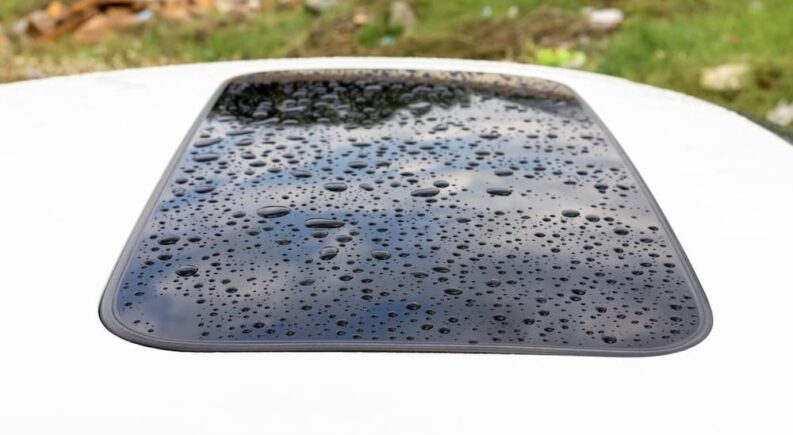Sunroofs are an increasingly popular feature in today’s vehicles, with over 40 percent of all new cars, trucks, and SUVs shipping with a sunroof. That’s up almost 10 percent compared to 10 years ago, proving just how common the feature has become. Between enjoying a little slice of the heavens above and the sense of open, airy space that a sunroof can create, it’s no wonder the feature is so prevalent in the modern automotive market. While many drivers think of a sunroof as being more of an aesthetic than a functional feature, they can actually play an important role in air circulation, helping to keep a vehicle well-ventilated on those steamy summer days, but what happens when sunroofs go bad?
At the end of the day, a sunroof is basically just another window and, as such, is susceptible to the same problems facing any car window. While they’re prone to broken glass, electrical issues, and rattling, leaks are one of the most common issues drivers will face when dealing with sunroofs. No one likes to feel that steady drip, drip, drip against the top of their head while riding through some stormy weather, but a leaky sunroof can have some much more serious consequences if left untreated.
From the hit on resale value to electrical and even health issues caused by mold, it can cause no shortage of problems, which raises the question: how to deal with a leaky sunroof? We’ll examine some common issues that can cause sunroof leaks and explore some simple DIY fixes that’ll go a long way in making your mobile shower a thing of the past.
Signs of a Leaky Sunroof
Spotting a leaky sunroof seems easy enough, but that’s not always the case. Sure, if you see water actively dripping from the sunroof, the investigation phase might not take that long, but it might not always be so obvious. Common signs of a leaky sunroof include a wet floor or upholstery, excessive condensation or fogging within the vehicle, and a musty, moldy smell that’s the tell-tale sign of mildew.
The only problem is that these symptoms aren’t exclusive to a leaky sunroof and could actually be caused by a leak in any number of components throughout the vehicle. A leak in any of your windows, including your windshield, might mimic the signs of a leaky sunroof, so it’s important to ensure you’ve identified the right component before launching into a repair project. If you’re dealing with a leaky windshield, moisture on the dashboard, or a whistling noise while driving might help to differentiate the issue. If any of your side windows are responsible for the leak, you might notice a damp door panel or electronics embedded in the door — like speakers, window and lock controls — not working properly.
Quarter windows and the rear windshield will typically have moisture located just beneath the glass if they’re the cause of the leak, but it’s not always the windows you have to watch out for. A faulty air conditioning condenser could lead to a damp floor after using the AC, and a broken heater core can also produce moisture, though it tends to have a slightly tint and noticeable chemical odor that will help set it apart from a regular water leak. If you’ve examined each of these components and don’t see any obvious signs of a leak, it might be time to move onto the sunroof.
Causes and Fixes
When it comes to sunroof leaks, there are three common culprits: worn rubber seals, clogged drainage tubes, and a damaged or misaligned open/close mechanism. In this next section, we’ll explore each of these issues and their common fixes.
Worn or Damaged Seals
The Problem: The first cause of a leaky sunroof is pretty easy to understand because sunroofs, like almost any other type of window, rely on a tight, rubberized seal to keep water on the right side of the glass. When these rubber seals become worn out due to sun, heat, age, and elemental exposure, they can start to crack, dry, or warp, which will cause no shortage of problems for drivers trying to arrive at their destination as dry as they were when they stepped into the car. A sunroof’s seal can also be cut, ripped, gashed, or otherwise compromised in a way that affects the performance or might be missing entirely due to an accident or vandalism.
The Fix: There’s no repairing a worn or damaged seal, so you’re probably going to be looking at a wholesale replacement. This project can be DIY but will require the removal of the entire sunroof and more than a little fiddling to get a good fit with the new seal. If you’re confident in your mechanical abilities — and think you can put everything back where you found it — a sunroof seal replacement should be well within your reach. Going with a pro will typically cost between $250 and $300, but it might be worth it if you want to guarantee a perfect fit.
Clogged Drains
The Problem: The second cause of sunroof leaks might be a little less obvious, but allow us to explain. Most drivers don’t realize that sunroofs do collect water during the course of normal operation. Sunroofs are designed so that any water that makes its way past the primary seal will gather in a shallow drainage gap that’s surrounded by a raised edge to prevent the water from leaking directly into the cabin. Water will always find the lowest point on any surface and, as such, is bound to gather in that tiny gap.
This drainage gap is subtly sloped towards two drain hoses located in the corners of the sunroof opening, which funnel waters away from the roof, down the door pillars, and out through tiny holes embedded in a vehicle’s rocker panels. This system does a great job of redirecting water away from the sunroof, but issues arise when other contaminants enter the mix. When dirt, leaves, and other road debris find their way into these drain plugs, they can become backed up, causing water to accumulate and, if not dealt with quickly, overflow and make a real mess.
The Fix: The first step in clearing your sunroof drains is to double-check the drains themselves. Lay down a tarp, towel, or other protective surface to protect your interior from water, open your sunroof all the way, and pour some water in the trough that rims the sunroof opening. If the water drains all the way to the ground — usually near your rear tires — a clogged drain might not be your problem. If, on the other hand, the water backs up or drains very slowly, it’s time to move ahead with the drain-clearing process.
Start by cleaning the area around the drains — and the whole drainage trough — with some ammonia-free glass cleaner and some paper towels. Next, use a small pipe cleaner, toothbrush, or some other long, narrow implement to clear the first few inches of the drain, as this is one of the most common places for blockages. If you managed to pull out some gunk, do the water test again to see if the issue is resolved. If not, use a small drain snake, cable, or something like a weed trimmer string to clean out the entire drainage line.
If you can’t find something small enough and have the tool on hand, you can also try using an air hose to force the blockage out using air pressure. No matter which approach you choose, take a gentle approach, as too much force on the drainage line can result in punctures, ruptures, and other damage that will require a much more annoying and expensive fix. Repeat the process until water poured into the drainage trough clears quickly and easily, and you’re good to go.
Damaged Mechanism
The Problem: Lastly, there’s damage to the sunroof mechanism itself. A system of motors and relays do all the heavy lifting when it comes to sliding, lifting, and lowering your sunroof panel, but they’re also all too susceptible to damage. When this mechanism is worn, broken, or misaligned, it can cause the sunroof to sit a little askew and prevent it from creating a tight, waterproof seal.
The Fix: Between the pulleys, motors, tracks, seals, and various hardware, fixing or replacing a damaged sunroof mechanism is usually a little too specialized for the average driver. If you’re mechanically inclined and want to dive in head-first, be our guest, but in most cases, this is one sunroof-related repair that should be left to the professionals. It won’t be a cheap fix, with sunroof replacement and repair running anywhere between $400 and $800, but unless you’re trying to achieve some weird life hack where you shower during your morning commute, it’s well worth it.

Identify the Issue Before It Becomes an Expensive Problem
When you know what to look for, identifying a leaky sunroof isn’t very difficult. Fixing it, on the other hand, isn’t always so simple. If you’re dealing with a clogged drainage hose, you might just be a few well-applied pipe cleaners away from a well-functioning sunroof, but unfortunately, it’s not always so simple. A worn or damaged sunroof mechanism can be a demanding job for the DIYer, and while we like to help our readers avoid the auto shop at all costs, the project is typically a little too involved for the home mechanic.
Getting the perfect fit can be elusive, and one wrong move could end up damaging a key component that could cause the relatively simple repair to balloon into a big-ticket project. Replacing a worn or compromised seal is a little more attainable but still requires patience and attention to detail, which can be hard for some drivers to summon. If you’re looking for a professional touch, your local dealership, auto body, or glass shop can be a great resource. That said, quickly and easily identifying a leaky sunroof is an important skill for any driver, allowing you to head off the issue before it gets out of hand and starts affecting your vehicle’s performance or resale value.

